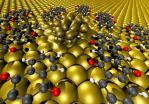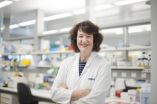(Press-News.org) The UK's national synchrotron facility, Diamond Light Source, is now the first and only place in Europe where pathogens requiring Containment Level 3 – including serious viruses such as those responsible for AIDS, Hepatitis and some types of flu – can be analysed at atomic and molecular level using synchrotron light. This special light allows scientists to study virus structures at intense levels of detail and this new facility extends that capability to many viruses that have a major global impact on human and animal health. Studying pathogens in this way has the potential to open up new paths for the development of therapeutic treatments and vaccines.
Presenting at the American Association for the Advancement of Science (AAAS 2013) in Boston on the latest virus work undertaken at Diamond, Prof Dave Stuart - Life Sciences Director at Diamond Light Source and Professor of Structural Biology at Oxford University - launches the new lab, Crystal, which will help scientists delve into the inner workings of pathogens and uncover the mechanisms of infection. Prof. Stuart comments:
"Crystal provides unique facilities in Europe for the study of serious viruses. Nowhere in the world can structures be so readily solved with the speed and efficiency that is now available at Diamond. As such, we anticipate interest from a number of groups in the UK, including the Particle Imaging Centre in Oxford, which provides a suite of contained laboratories including a crystallisation laboratory, to support the preparation of sample prior to study at Diamond. This is great news for the UK research community, as the facility will be a resource with the potential to provide new pathways for treatment."
Diamond already has a strong track record of studying viruses at lower levels of containment. In 2012, scientists determined the structure of the virus that causes hand-foot-and-mouth disease, which can cause severe central nervous system disease in children and poses serious public health threats across the Asia-Pacific region. Some 1.7 million cases were reported by the Chinese Ministry of Health during 2010, and there is no vaccine or therapy available.
An Anglo-Chinese collaboration used the facilities at Diamond to solve the structure of the Human Enterovirus 71 (EV71), which is the root cause of the disease. Using synchrotron light, the team were able to visualise the virus in different states and collect a series of structures, from which they were able to uncover a detailed picture of the virus's actions in sequence - rather than being a rigid object, the virus appears to actually "breathe". Such visualisation requires specialist microscopes ten thousand times more powerful than standard laboratory microscopes.
This achievement creates new opportunities for therapies being developed. Prof Stuart explains:
"Together with our Chinese Colleagues, we have now uncovered the structure of EV71 and identified the process by which the virus spreads throughout cells in the human body. These findings can now be used to develop new treatments for hand-foot-and-mouth; and also directly translated to other viruses of the same family, including polio and some forms of the common cold."
The solving of hand, foot and mouth virus demonstrates the potential impact that the new capabilities could have. Crystal at the Diamond synchrotron enables researchers to rapidly visualise viruses in their entirety and at incredible scales. The facility's brilliant beams of X-rays allow scientists to study crystallised virus particles, and so produce a comprehensive 3D image of the virus structure. By identifying the virus structure in atomic detail, scientists can target research into vaccines and anti-viral drugs.
The facility is the only one of its kind in Europe and one of only two in the world. Dr Katherine McAuley, science leader for the facility concludes, "Crystal is a major advance, not just for the UK, but for Europe at large. Given the groundwork that has been performed at Diamond so far on viruses like the hand-foot-and-mouth, we are introducing a step change in research capabilities, so that more complex studies can be undertaken in a swift and effective way. The unique capabilities that the facility offers are expected to draw scientists from around the world, and establish the nation's synchrotron as a hub of world-leading research into disease prevention."
INFORMATION:
For more information and media enquiries, please contact Silvana Westbury 0044(0)7920594660 or Isabelle Boscaro-Clarke 0044 (0)7990797916 or the press office on 0044 (0)1235 778639.
Supporting images and animations can be viewed and downloaded at ftp://ftpanon.diamond.ac.uk/AAAS2013
Note to Editors
About Diamond Light Source
Diamond Light Source is funded by the UK Government via the Science and Technology Facilities Council (STFC) and by the Wellcome Trust.
For more information about Diamond visit www.diamond.ac.uk
Diamond generates extremely intense pin-point beams of synchrotron light of exceptional quality ranging from X-rays, ultra-violet and infrared. For example Diamond's X-rays are around 100 billion times brighter than a standard hospital X-ray machine.
Diamond Light Source is used by over 3,000 academic and industrial researchers across a wide range of disciplines including structural biology, health and medicine, solid-state physics, materials & magnetism, nanoscience, electronics, earth & environmental sciences, chemistry, cultural heritage, energy and engineering.
Many of our everyday commodities that we take for granted, from food manufacturing to cosmetics, from revolutionary drugs to surgical tools, from computers to mobile phones, have all been developed or improved using synchrotron light.
Diamond brings benefits to:
Biology and medicine. For example, the fight against illnesses such as Parkinson's, Alzheimer's, osteoporosis and many cancers will benefit from the new research techniques available at Diamond.
The physical and chemical sciences. For example, in the near future, engineers will be able to image their structure down to an atomic scale, helping them to understand the way impurities and defects behave and how they can be controlled.
The Environmental and Earth sciences. For example, Diamond helps researchers to identify organisms that target specific types of contaminant in the environment which can potentially lead to identifying cheap and effective ways for cleaning polluted land.
More images and visuals available: ftp://ftpanon.diamond.ac.uk/AAAS2013
Diamond sheds light on basic building blocks of life
2013-02-18
ELSE PRESS RELEASES FROM THIS DATE:
Organic electronics -- how to make contact between carbon compounds and metal
2013-02-18
Until now, however, it was practically impossible to accurately predict which molecules performed well on the job. They basically had to be identified by trial-and-error.
Now, an international team of scientists around Dr. Georg Heimel and Prof. Norbert Koch from the HZB and the Humboldt University Berlin has unraveled the mystery of what these molecules have in common. Their discovery enables more focused improvements to contact layers between metal electrodes and active materials in organic electronic devices.
"We have been working on this question for a number of ...
'Activating' RNA takes DNA on a loop through time and space
2013-02-18
Long segments of RNA— encoded in our DNA but not translated into protein—are key to physically manipulating DNA in order to activate certain genes, say researchers at The Wistar Institute. These non-coding RNA-activators (ncRNA-a) have a crucial role in turning genes on and off during early embryonic development, researchers say, and have also been connected with diseases, including some cancers, in adults.
In an online article of the journal Nature, a team of scientists led by Wistar's Ramin Shiekhattar, Ph.D., detail the mechanism by which long non-coding RNA-activators ...
Dopants dramatically alter electronic structure of superconductor
2013-02-18
UPTON, NY - Over the last quarter century, scientists have discovered a handful of materials that can be converted from magnetic insulators or metals into "superconductors" able to carry electrical current with no energy loss-an enormously promising idea for new types of zero-resistance electronics and energy-storage and transmission systems. At present, a key step to achieving superconductivity (in addition to keeping the materials very cold) is to substitute a different kind of atom into some positions of the "parent" material's crystal framework. Until now, scientists ...
'Snooze button' on biological clocks improves cell adaptability
2013-02-18
The circadian clocks that control and influence dozens of basic biological processes have an unexpected "snooze button" that helps cells adapt to changes in their environment.
A study by Vanderbilt University researchers published online Feb. 17 by the journal Nature provides compelling new evidence that at least some species can alter the way that their biological clocks function by using different "synonyms" that exist in the genetic code.
"This provides organisms with a novel and previously unappreciated mechanism for responding to changes in their environment," said ...
Microbes team up to boost plants' stress tolerance
2013-02-18
UNIVERSITY PARK, PA. -- While most farmers consider viruses and fungi potential threats to their crops, these microbes can help wild plants adapt to extreme conditions, according to a Penn State virologist.
Discovering how microbes collaborate to improve the hardiness of plants is a key to sustainable agriculture that can help meet increasing food demands, in addition to avoiding possible conflicts over scare resources, said Marilyn Roossinck, professor of plant pathology and environmental microbiology, and biology.
"It's a security issue," Roossinck said. "The amount ...
Ancient teeth bacteria record disease evolution
2013-02-18
DNA preserved in calcified bacteria on the teeth of ancient human skeletons has shed light on the health consequences of the evolving diet and behaviour from the Stone Age to the modern day.
The ancient genetic record reveals the negative changes in oral bacteria brought about by the dietary shifts as humans became farmers, and later with the introduction of food manufacturing in the Industrial Revolution.
An international team, led by the University of Adelaide's Centre for Ancient DNA (ACAD) where the research was performed, has published the results in Nature Genetics ...
Wiring the ocean
2013-02-18
For most people, the sea is a deep, dark mystery. That is changing, though, as scientists find innovative ways to track the movements of ocean-going creatures.
Stanford marine sciences professor and Stanford Woods Institute Senior Fellow Barbara Block is using technology to enable live feeds of animal movements relayed by a series of "ocean WiFi hotspots." This could help protect marine ecosystems by revolutionizing how we understand their function, population structure, fisheries management and species' physiological and evolutionary constraints.
Block will explain ...
Excessive TV in childhood linked to long-term antisocial behaviour
2013-02-18
Children and adolescents who watch a lot of television are more likely to manifest antisocial and criminal behaviour when they become adults, according to a new University of Otago, New Zealand, study published online in the US journal Pediatrics.
The study followed a group of around 1000 children born in the New Zealand city of Dunedin in 1972-73. Every two years between the ages of 5 and 15, they were asked how much television they watched. Those who watched more television were more likely to have a criminal conviction and were also more likely to have antisocial ...
Pathway controlling cell growth revealed
2013-02-18
A Melbourne-based research team has discovered a genetic defect that can halt cell growth and force cells into a death-evading survival state.
The finding has revealed an important mechanism controlling the growth of rapidly-dividing cells that may ultimately lead to the development of new treatments for diseases including cancer.
The discovery was made by Associate Professor Joan Heath, Dr Yeliz Boglev and colleagues at the Melbourne-Parkville Branch of the Ludwig Institute for Cancer Research. Dr Kate Hannan, Associate Professor Rick Pearson and Associate Professor ...
Douglas A. Melton to Keynote present at Stem Cell Summit - Apr 2013 in Boston MA
2013-02-18
Douglas A. Melton will give a keynote presentation on "How To Make Pancreatic Beta Cells" at the Stem Cell Summit 2013 (Apr 29-30, 2013 in Boston MA).
Dr. Melton's presentation will focus on the research of making human pancreatic beta cells to study and treat diabetes. This goal is pursued with two main approaches: directing the differentiation of stem cells into beta cells and studying the signals that replicate pre-existing beta cells. The signals that direct stem and progenitor cells toward a mature beta cell phenotype will be described as well as work ...


